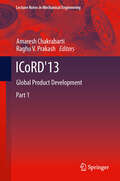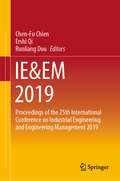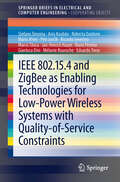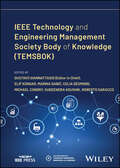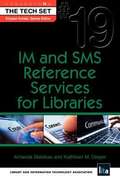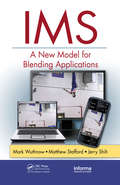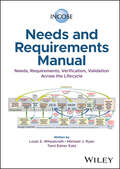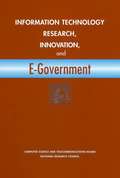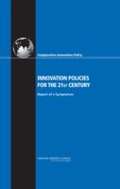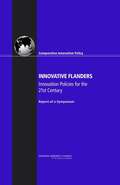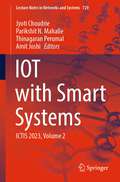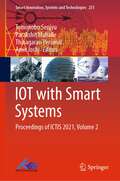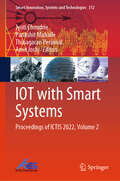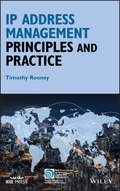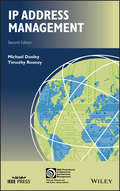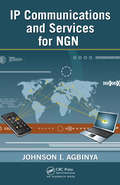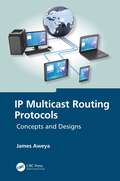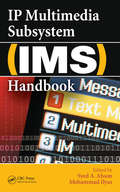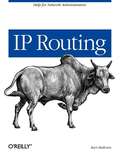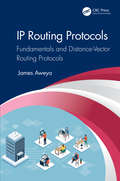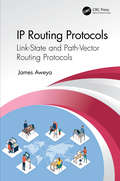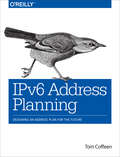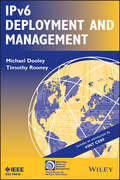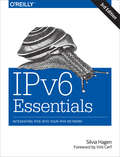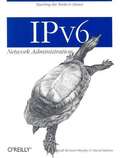- Table View
- List View
ICoRD'13: Global Product Development
by Amaresh Chakrabarti Raghu V. PrakashThis book showcases over 100 cutting-edge research papers from the 4th International Conference on Research into Design (ICoRD'13) - the largest in India in this area - written by eminent researchers from over 20 countries, on the design process, methods and tools, for supporting global product development (GPD). The special features of the book are the variety of insights into the GPD process, and the host of methods and tools at the cutting edge of all major areas of design research for its support. The main benefit of this book for researchers in engineering design and GPD are access to the latest quality research in this area; for practitioners and educators, it is exposure to an empirically validated suite of methods and tools that can be taught and practiced.
IE&EM 2019: Proceedings of the 25th International Conference on Industrial Engineering and Engineering Management 2019
by Chen-Fu Chien Ershi Qi Runliang DouThis book records the new research findings and development in the field of industrial engineering and engineering management, and it will serve as the guidebook for the potential development in future. It gathers the accepted papers from the 25th International conference on Industrial Engineering and Engineering Management held at Anhui University of Technology in Maanshan during August 24-25, 2019. The aim of this conference was to provide a high-level international forum for experts, scholars and entrepreneurs at home and abroad to present the recent advances, new techniques and application, to promote discussion and interaction among academics, researchers and professionals to promote the developments and applications of the related theories and technologies in universities and enterprises, and to establish business or research relations to find global partners for future collaboration in the field of Industrial Engineering. It addresses diverse themes in smart manufacturing, artificial intelligence, ergonomics, simulation and modeling, quality and reliability, logistics engineering, data mining and other related fields. This timely book summarizes and promotes the latest achievements in the field of industrial engineering and related fields over the past year, proposing prospects and vision for the further development.
IEEE 802.15.4 and ZigBee as Enabling Technologies for Low-Power Wireless Systems with Quality-of-Service Constraints
by Nuno Pereira Anis Koubâa Mário Alves Petr Jurčík Ricardo Severino Stefano Tennina Roberta Daidone Gianluca Dini Marco Tiloca Mélanie Bouroche Jan-Hinrich Hauer Eduardo TovarThis book outlines the most important characteristics of IEEE 802.15.4 and ZigBee and how they can be used to engineer Wireless Sensor Network (WSN) systems and applications, with a particular focus on Quality-of-Service (QoS) aspects. It starts by providing a snapshot of the most relevant features of these two protocols, identifying some gaps in the standard specifications. Then it describes several state-of-the-art open-source implementations, models and tools that have been designed by the authors and have been widely used by the international community. The book also outlines the fundamental performance limits of IEEE 802.15.4/ZigBee networks, based on well-sustained analytical, simulation and experimental models, including how to dimension such networks to optimize delay/energy trade-offs.
IEEE Technology and Engineering Management Society Body of Knowledge (IEEE Press Series on Technology Management, Innovation, and Leadership)
by Celia Desmond Elif Kongar Marina Dabić Gustavo Giannattasio Michael Condry Sudeendra Koushik Roberto SaraccoIEEE Technology and Engineering Management Society Body of Knowledge (TEMSBOK) IEEE TEMS Board of Directors-approved body of knowledge dedicated to technology and engineering management The IEEE Technology and Engineering Management Society Body of Knowledge (TEMSBOK) establishes a set of common practices for technology and engineering management, acts as a reference for entrepreneurs, establishes a basis for future official certifications, and summarizes the literature on the management field in order to publish reference documentation for new initiatives. The editors have used a template approach with authors that instructed them on how to introduce their manuscript, how to organize the technology and area fundamentals, the managing approach, techniques and benefits, realistic examples that show the application of concepts, recommended best use (focusing on how to identify the most adequate approach to typical cases), with a summary and conclusion of each section, plus a list of references for further study. The book is structured according to the following area knowledge chapters: business analysis, technology adoption, innovation, entrepreneurship, project management, digital disruption, digital transformation of industry, data science and management, and ethics and legal issues. Specific topics covered include: Market requirement analysis, business analysis for governance planning, financial analysis, evaluation and control, and risk analysis of market opportunities Leading and managing working groups, optimizing group creation and evolution, enterprise agile governance, and leading agile organizations and working groups Marketing plans for new products and services, risk analysis and challenges for entrepreneurs, and procurement and collaboration Projects, portfolios and programs, economic constraints and roles, integration management and control of change, and project plan structure The IEEE Technology and Engineering Management Society Body of Knowledge (TEMSBOK) will appeal to engineers, graduates, and professionals who wish to prepare for challenges in initiatives using new technologies, as well as managers who are responsible for conducting business involving technology and engineering.
IM and SMS Reference Services for Libraries (Tech Set #19)
by Kathleen M. Dreyer Amanda BielskasLibraries that have considered incorporating IM or text services, but have not yet done so, would do especially well to consult this book. - Alexa Pearce, Librarian for Journalism, Media, Culture & Communication at Bobst Library at New York University Users want real-time answers to their reference questions wherever and whenever they are. Increasingly, that means SMS and IM services. Providing those is easier than you might think! This manual offers information on the technological aspects of providing such a service, as well as how to create a training program for librarians and how to build an internship program to expand the service. The authors walk you through choosing the right software, including setting up a Google Voice account instead of buying a cell phone for your text messaging reference service. It also covers how to assess the needs of your library, get staff buy-in to implement a new program and change the culture at your library, as well as organize and implement a staff training program.
IMS: A New Model for Blending Applications
by Matthew Stafford Mark Wuthnow Jerry ShihIP Multimedia Subsystem (IMS) technology, which merges the Internet with interactive telecommunications, represents the here and now for today's packet-switched networks. Consequently, anyone working with or around these converging fields needs to possess a fundamental understanding of IMS and how this technology is poised to change the way new app
INCOSE Needs and Requirements Manual: Needs, Requirements, Verification, Validation Across the Lifecycle
by Michael J. Ryan Louis S. Wheatcraft Tami Edner KatzComplete and comprehensive manual for eliciting, defining, and managing needs and requirements, integration, verification, and validation across the lifecycle The INCOSE Needs and Requirements Manual presents product development and systems engineering practices, activities, and artifacts from the perspective of needs, requirements, verification, and validation across the system lifecycle. Composed of 16 chapters, this book provides practical guidance to help organizations understand the importance of lifecycle concepts, needs, requirements, verification, and validation activities, enabling them to successfully and effectively implement these activities during product development, systems engineering, and project management. The parent handbook published by Wiley, INCOSE Systems Engineering Handbook, divides the system lifecycle into a series of processes, with each process described in terms of a series of activities. This Manual provides more detail needed by practitioners to successfully implement these activities, with guidance and lessons learned from hundreds of years of collective experience of the authors, contributors, and reviewers. For example, while the Handbook mentions the need to define the problem statement, mission, goals, and objectives for a system, the Manual provides detailed guidance on doing so. Sample topics covered in the INCOSE Needs and Requirements Manual include: Defining the problem, opportunity, or threat and defining a mission statement, goals, objectives, and measures.Identifying external and internal stakeholders, eliciting stakeholder needs and requirements, defining drivers and constraints, and assessing risk.Performing lifecycle concept analysis and maturation and defining an integrated set of needs that represents the scope of the project.Transforming the integrated set of needs into well-formed design input requirements.Using attributes to manage needs and requirements across the lifecycle.Continuous integration, verification, and validation across the lifecycle.Moving between levels of the architecture, flow down and allocation of requirements, and budgeting performance, resource, and quality requirements.Defining the system verification and system validation success criteria, method, strategy, and responsible organizations.Planning and executing successful system verification and validation programs.Managing needs, requirements, verification, and validation across the lifecycle.Understanding the importance of an integrated, collaborative project team and effective communication between team members The INCOSE Needs and Requirements Manual is an essential accompanying reference to the INCOSE Systems Engineering Handbook for novice and seasoned system engineers, software engineers, project managers, product developers, tool vendors, course developers, educators, trainers, customers, suppliers, non-SE stakeholders , as well as researchers and students studying systems engineering and systems design.
INFORMATION TECHNOLOGY RESEARCH, INNOVATION, and E-Government
by Committee on Computing Communications Research to Enable Better Use of Information Technology in GovernmentGovernments have done much to leverage information technology to deploy e-government services, but much work remains before the vision of e-government can be fully realized. Information Technology Research, Innovation, and E-government examines the emerging visions for e-government, the technologies required to implement them, and approaches that can be taken to accelerate innovation and the transition of innovative information technologies from the laboratory to operational government systems. In many cases, government can follow the private sector in designing and implementing IT-based services. But there are a number of areas where government requirements differ from those in the commercial world, and in these areas government will need to act on its role as a “demand leader.” Although researchers and government agencies may appear to by unlikely allies in this endeavor, both groups have a shared interest in innovation and meeting future needs.E-government innovation will require addressing a broad array of issues, including organization and policy as well as engineering practice and technology research and development, and each of these issues is considered in the book.
INNOVATION POLICIES FOR THE 21ST CENTURY: Report of a Symposium
by National Research Council of the National AcademiesTo mark the opening of a study of Comparative Innovation Policy: Best Practice for the 21st Century the Board on Science, Technology, and Economic Policy (STEP) convened a symposium providing an overview of areas to be examined in the study and topics requiring further policy attention. The event highlighted the policies and programs of leading nations and provided valuable insights into some of the common challenges of growing and supporting high-technology industry and the commercialization of public investments in R&D. This report contains a summary of the symposium proceedings and an introduction analyzing the issues and placing them in a broader policy context.
INNOVATIVE FLANDERS: Innovation Policies for the 21st Century
by National Research Council of the National AcademiesRecognizing that innovation is the key to international competitiveness in the 21st century, policymakers around the world are seeking more effective ways to translate scientific and technological knowledge into new products, processes, and businesses. They have initiated major programs, often with substantial funding, that are designed to attract, nurture, and support innovation and high-technology industries within their national economies. To help U.S. policymakers become more aware of these developments, a committee of the National Academies' Board on Science, Technology, and Economic Policy undertook a review of the goals, concept, structure, operation, funding levels, and evaluation efforts of significant innovation programs around the world. As a part of this effort, the committee identified Flanders, a region of Belgium with substantial autonomy, which is recognized for its comprehensive approach to innovation. Based on initial meetings in Washington and Brussels, and with the endorsement of Flanders Vice Minister-President Fientje Moerman, it was agreed to organize a conference that would review regional innovation policies in the context of the policies and programs of the Flanders government, and their interaction with those of the European Union. This book provides a summary of that symposium.
IOT with Smart Systems: ICTIS 2023, Volume 2 (Lecture Notes in Networks and Systems #720)
by Amit Joshi Jyoti Choudrie Parikshit N. Mahalle Thinagaran PerumalThis book gathers papers addressing state-of-the-art research in all areas of information and communication technologies and their applications in intelligent computing, cloud storage, data mining and software analysis. It presents the outcomes of the Seventh International Conference on Information and Communication Technology for Intelligent Systems (ICTIS 2023), held in Ahmedabad, India. The book is divided into two volumes. It discusses the fundamentals of various data analysis techniques and algorithms, making it a valuable resource for researchers and practitioners alike.
IOT with Smart Systems: Proceedings of ICTIS 2021, Volume 2 (Smart Innovation, Systems and Technologies #251)
by Amit Joshi Tomonobu Senjyu Thinagaran Perumal Parakshit MahalleThis book gathers papers addressing state-of-the-art research in all areas of information and communication technologies and their applications in intelligent computing, cloud storage, data mining and software analysis. It presents the outcomes of the Fifth International Conference on Information and Communication Technology for Intelligent Systems (ICTIS 2021), held in Ahmedabad, India. The book is divided into two volumes. It discusses the fundamentals of various data analysis techniques and algorithms, making it a valuable resource for researchers and practitioners alike.
IOT with Smart Systems: Proceedings of ICTIS 2022, Volume 2 (Smart Innovation, Systems and Technologies #312)
by Amit Joshi Jyoti Choudrie Parikshit Mahalle Thinagaran PerumalThis book gathers papers addressing state-of-the-art research in all areas of information and communication technologies and their applications in intelligent computing, cloud storage, data mining and software analysis. It presents the outcomes of the Sixth International Conference on Information and Communication Technology for Intelligent Systems (ICTIS 2022), held in Ahmedabad, India. The book is divided into two volumes. It discusses the fundamentals of various data analysis techniques and algorithms, making it a valuable resource for researchers and practitioners alike.
IP Address Management Principles and Practice
by Timothy RooneyThis book will be the first covering the subject of IP address management (IPAM). The practice of IPAM includes the application of network management disciplines to IP address space and associated network services, namely DHCP (Dynamic Host Configuration Protocol) and DNS (Domain Name System). The consequence of inaccurately configuring DHCP is that end users may not be able to obtain IP addresses to access the network. Without proper DNS configuration, usability of the network will greatly suffer as the name-to-address lookup process may fail. Imagine having to navigate to a website or send an email or an instant message by IP address instead of by name! It's equally important that these DHCP and DNS configurations be based on a common IP address plan, which maps out the IP address hierarchy, subnets, address pools, and domains.IPAM applies management disciplines to these core services, including configuration, change control, auditing, reporting and so on, and they are necessary given the absolute requirement for properly managing IP space and DHCP and DNS servers. The linkages among an IP address plan, DHCP server configuration and DNS server configuration are inseparable; a change of an IP address will affect DNS information and perhaps DHCP as well. These functions provide the foundation for today's converged services IP networks, so they need to be managed using a rigorous approach.Today, there is no single book that covers the management of these linkages and services they provide; IP Address Management Principles and Practice will fill that gap. While several books are available for leading vendors' DHCP and DNS services implementations, few exist for IP address planning, and none exist that unifies these three topics.To obtain a free copy of the IPAM Configuration Guide please send an email to:ieeeproposals@wiley.com
IP Address Management: Principles And Practice (IEEE Press Series on Networks and Service Management #16)
by Michael Dooley Timothy RooneyRediscover fundamental and advanced topics in IPAM, DNS, DHCP and other core networking technologies with this updated one-stop reference The thoroughly revised second edition of IP Address Management is the definitive reference for working with core IP management technologies, like address allocation, assignment, and network navigation via DNS. Accomplished professionals and authors Timothy Rooney and Michael Dooley offer readers coverage of recent IPAM developments in the world of cloud computing, Internet of Things (IoT), and security, as well as a comprehensive treatment of foundational concepts in IPAM. The new edition addresses the way that IPAM needs and methods have evolved since the publication of the first edition. The book covers the impact of mainstream use of private and public cloud services, the maturation of IPv6 implementations, new DNS security approaches, and the proliferation of IoT devices. The authors have also reorganized the flow of the book, with much of the technical reference material appearing at the end and making for a smoother and simpler reading experience. The 2nd edition of IP Address Management also covers topics like such as: Discussions about the fundamentals of Internet Protocol Address Management (IPAM), including IP addressing, address allocation and assignment, DHCP, and DNS An examination of IPAM practices, including core processes and tasks, deployment strategies, IPAM security best-practices, and DNS security approaches A treatment of IPAM in the modern context, including how to adapt to cloud computing, the Internet of Things, IPv6, and new trends in IPAM A one-stop reference for IPAM topics, including IP addressing, DHCP, DNS, IPv6, and DNS security Perfect for IP network engineers and managers, network planners, network architects, and security engineers, the second edition of IP Address Management also belongs on the bookshelves of senior undergraduate and graduate students studying in networking, information technology, and computer security-related courses and programs.
IP Communications and Services for NGN
by Johnson I AgbinyaRapid deployment and acceptance of broadband networks, including the 802.11 a/b/g, 3G cellular networks, WiMAX, and emerging 4G cellular IP networks, have sparked a growing reliance on voice over IP and the quickly emerging IP TV and Mobile TV. Providing the necessary background and technical understanding to stay abreast of and even ahead of the IP trend, IP Communications and Services for NGN explores IP development for the delivery of next generation mobile services. Packed with detailed illustrations, this cutting-edge reference examines the primary IP protocols (IPv4 and IPv6), real-time protocols, and three major IP services (VoIP, IPTV, and Mobile TV). It clearly explains the different architectures of fixed, mobile, and wireless networks along with the major advantages and disadvantages of each. It includes coverage of the latest in:The VoIP MarketSCTP and Vertical HandoffRSVP: Resource Reservation ProtocolMPLS: MultiProtocol Label SwitchingSIP: Session Initiation ProtocolIMS: IP Multimedia SubsystemRTSP: Real-Time Streaming ProtocolRTP: Real-Time Transport ProtocolIPTV System Architectures and IPTV System DescriptionsWith a detailed listing of commonly used acronyms, along with a clear description of the role IP is likely to play in the development of next generation mobile services, this book provides educators, industry practitioners, regulators, and subscribers with the ideal starting point for developing the understanding required to deploy, train, and use IP services effectively and efficiently.
IP Multicast Routing Protocols: Concepts and Designs
by James AweyaThis book discusses the fundamental concepts that are essential to understanding IP multicast communication. The material covers the well‑known IP multicast routing protocols, along with the rationale behind each protocol. The book starts with the basic building blocks of multicast communications and networks, then progresses into the common multicast group management methods used, and finally into the various, well‑known multicast routing protocols used in today’s networks. IP multicast provides significant benefits to network operators by allowing the delivery of information to multiple receivers simultaneously with less network bandwidth consumption than using unicast transmission. Applications that can benefit greatly from multicast communications and multicast‑enabled networks include audio and video conferencing, collaborative computing, online group learning and training, multimedia broadcasting, multi‑participant online gaming, and stock market trading. This book’s goal is to present the main concepts and applications, allowing readers to develop a better understanding of IP multicast communication. IP Multicast Routing Protocols: Concepts and Designs presents material from a practicing engineer’s perspective, linking theory and fundamental concepts to common industry practices and real‑world examples. The discussion is presented in a simple style to make it comprehensible and appealing to undergraduate‑ and graduate‑level students, research and practicing engineers, scientists, IT personnel, and network engineers. It is geared toward readers who want to understand the concepts and theory of IP multicast routing protocols, yet want these to be tied to clearly illustrated and close‑to‑real‑world example systems and networks.
IP Multimedia Subsystem (IMS) Handbook
by Mohammad Ilyas Syed A. AhsonTake Part in the Future of Wireless/Wireline Convergence The IP multimedia subsystem (IMS), established as the foundation for future wireless and wireline convergence, is the bedrock that will facilitate easy deployment on new, rich, personalized multimedia communication services that mix telecom and data services. Designers, planners, and researchers of communication systems will need to make full use of the technology occurring with this convergence if they want to be the ones providing end users with new and efficient services that are as cost-effective as they are innovative. To provide researchers and technicians with the tools they need to optimize their role in this communication revolution, the IP Multimedia Subsystem (IMS) Handbook presents all the technical aspects of the IMS needed to support the growth of digital traffic and the implementation of underlying networks. This guide covers everything from basic concepts to research-grade material, including the future direction of the architecture. Organized in three sections, the book brings together the technical savvy of 50 pioneering experts from around the world, providing complete coverage of relevant concepts, technologies, and services. Learn How IMS Will Speed InnovationFilling the gap between existing traditional telecommunications and Internet technologies, IMS has led to an environment in which new services and concepts are introduced more quickly than ever before, such as reusable service components and real-time integration. The technology promises to be a cost-effective evolutionary path to future wireless and wireline convergences that will meet next-generation service requirements.
IP Routing
by Ravi MalhotraThis concise guide offers the basic concepts of IP routing, free of hype and jargon. It begins with the simplest routing protocol, RIP, and then proceeds in successive chapters to IGRP, EIGRP, RIP2, OSPF, and finally to the most complex, BGP. By the end, you will have mastered not only the fundamentals of all the major routing protocols, but also the underlying principles on which they are based.
IP Routing Protocols: Fundamentals and Distance-Vector Routing Protocols
by James AweyaThis book focuses on the fundamental concepts of IP routing and distance-vector routing protocols (RIPv2 and EIGRP). It discusses routing protocols from a practicing engineer’s perspective, linking theory and fundamental concepts to common practices and everyday examples. The book benefits and reflects the author’s more than 22 years of designing and working with IP routing devices and protocols (and Telecoms systems, in general). Every aspect of the book is written to reflect current best practices using real-world examples. This book describes the various methods used by routers to learn routing information. The author includes discussion of the characteristics of the different dynamic routing protocols, and how they differ in design and operation. He explains the processing steps involved in forwarding IP packets through an IP router to their destination and discusses the various mechanisms IP routers use for controlling routing in networks. The discussion is presented in a simple style to make it comprehensible and appealing to undergraduate and graduate level students, research and practicing engineers, scientists, IT personnel, and network engineers. It is geared toward readers who want to understand the concepts and theory of IP routing protocols, through real-world example systems and networks. Focuses on the fundamental concepts of IP routing and distance-vector routing protocols (RIPv2 and EIGRP). Describes the various methods used by routers to learn routing information. Includes discussion of the characteristics of the different dynamic routing protocols, and how they differ in design and operation. Provides detailed descriptions of the most common distance-vector routing protocols RIPv2 and EIGRP. Discusses the various mechanisms IP routers use for controlling routing in networks. James Aweya, PhD, is a chief research scientist at the Etisalat British Telecom Innovation Center (EBTIC), Khalifa University, Abu Dhabi, UAE. He has authored four books including this book and is a senior member of the Institute of Electrical and Electronics Engineers (IEEE).
IP Routing Protocols: Link-State and Path-Vector Routing Protocols
by James AweyaThis book discusses link-state routing protocols (OSPF and IS-IS), and the path-vector routing protocol (BGP). It covers their most identifying characteristics, operations, and the databases they maintain. Material is presented from a practicing engineer’s perspective, linking theory and fundamental concepts to common practices and real-world examples. Every aspect of the book is written to reflect current best practices using real-world examples. The book begins with a detailed description of the OSPF area types and hierarchical routing, and the different types of routers used in an OSPF autonomous system. The author goes on to describe in detail the different OSPF packet types, and inbound and outbound processing of OSPF link-state advertisements (LSAs). Next, the book gives an overview of the main features of IS-IS. The author then discusses the two-level routing hierarchy for controlling the distribution of intra-domain (Level 1) and inter-domain (Level 2) routing information within an IS-IS routing domain. He then describes in detail IS-IS network address formats, IS-IS routing metrics, IS-IS packet types, IS-IS network types and adjacency formation, IS-IS LSDB and synchronization, and IS-IS authentication. The book then reviews the main concepts of path-vector routing protocols, and describes BGP packet types, BGP session states and Finite State Machine, BGP path attributes types, and BGP Autonomous System Numbers (ASNs). Focuses solely on link-state routing protocols (OSPF and IS-IS), and the only path-vector routing protocol in use today (BGP). Reviews the basic concepts underlying the design of IS-IS and provides a detailed description of IS-IS area types and hierarchical routing, and the different types of routers used by IS-IS. Discusses the two-level routing hierarchy for controlling the distribution of intra-domain (Level 1) and inter-domain (Level 2) routing information within an IS-IS routing domain. Describes in detail BGP packet types, BGP session states and Finite State Machine, BGP path attributes types, and BGP ASNs, includes a high-level view of the typical BGP router and its components, and inbound and outbound message processing. James Aweya, PhD, is a chief research scientist at the Etisalat British Telecom Innovation Center (EBTIC), Khalifa University, Abu Dhabi, UAE. He has authored four books including this book and is a senior member of the Institute of Electrical and Electronics Engineers (IEEE).
IPv6 Address Planning: Designing an Address Plan for the Future
by Tom CoffeenIf you’re ready to join the move to IPv6, this comprehensive guide gets you started by showing you how to create an effective IPv6 address plan. In three example-driven sections—preparation, design, and maintenance—you’ll learn principles and best practices for designing, deploying, and maintaining an address plan far beyond what’s possible with IPv4 networks.During the course of the book, you’ll walk through the process of building a sample address plan for a fictional company. Enterprise IT network architects, engineers, and administrators will see firsthand how IPv6 provides opportunities for creating an operationally efficient plan that’s scalable, flexible, extensible, manageable, and durable.Explore IPv6 addressing basics, including representation, structure, and typesManage risks and costs by using a three-phase approach for deploying IPv6Dig into IPv6 subnetting methods and learn how they differ from IPv4Determine the appropriate size and type of the IPv6 allocation you requireApply current network management tools to IPv6Use IPv6 renumbering methods that enable greater network scale and easier integrationImplement policies and practices to keep IPv6 addresses reachable
IPv6 Deployment and Management (IEEE Press Series on Networks and Service Management #22)
by Michael Dooley Timothy RooneyWith the announcement in 2011 that the current Internet Protocol (IP), IPv4, has nearly run out, interest in IPv6 -- the latest IP version -- has grown substantially. This book describes IPv6 technology and its repercussions on organizations, including strategies and techniques for assessing the impact of deploying IPv6 on a network, discovering current IP assets, assessing network readiness, creating a plan to deploy IPv6 while retaining IPv4 connectivity, and for managing a dual protocol IPv4-IPv6 network. It is a must read for IP network engineers, managers, and those who work in IT.
IPv6 Essentials: Integrating IPv6 into Your IPv4 Network
by Silvia HagenIf your organization is gearing up for IPv6, this in-depth book provides the practical information and guidance you need to plan for, design, and implement this vastly improved protocol. Author Silvia Hagen takes system and network administrators, engineers, and network designers through the technical details of IPv6 features and functions, and provides options for those who need to integrate IPv6 with their current IPv4 infrastructure.The flood of Internet-enabled devices has made migrating to IPv6 a paramount concern worldwide. In this updated edition, Hagen distills more than ten years of studying, working with, and consulting with enterprises on IPv6. It’s the only book of its kind.IPv6 Essentials covers:Address architecture, header structure, and the ICMPv6 message formatIPv6 mechanisms such as Neighbor Discovery, Stateless Address autoconfiguration, and Duplicate Address detectionNetwork-related aspects and services: Layer 2 support, Upper Layer Protocols, and ChecksumsIPv6 security: general practices, IPSec basics, IPv6 security elements, and enterprise security modelsTransitioning to IPv6: dual-stack operation, tunneling, and translation techniquesMobile IPv6: technology for a new generation of mobile servicesPlanning options, integration scenarios, address plan, best practices, and dos and don’ts
IPv6 Network Administration
by David Malone Niall MurphyThis essential guide explains what works, what doesn't, and most of all, what's practical about IPv6--the next-generation Internet standard. A must-have for network administrators everywhere looking to fix their network's scalability and management problems. Also covers other IPv6 benefits, such as routing, integrated auto-configuration, quality-of-services (QoS), enhanced mobility, and end-to-end security.
